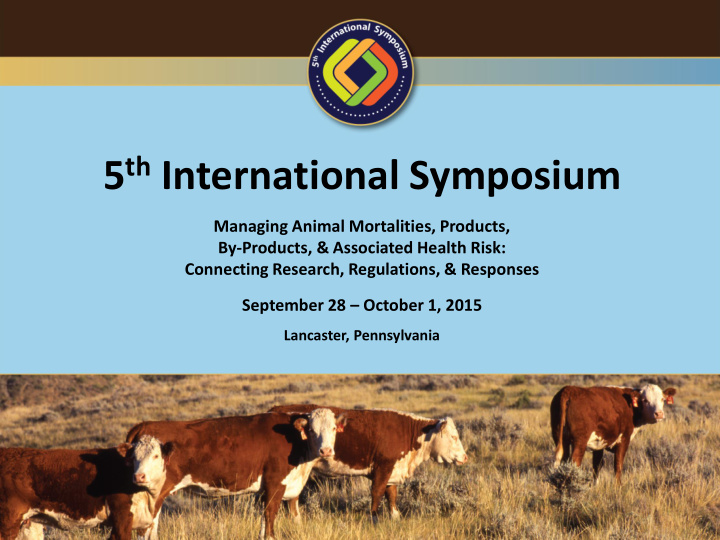



5 th International Symposium Managing Animal Mortalities, Products, By-Products, & Associated Health Risk: Connecting Research, Regulations, & Responses September 28 – October 1, 2015 Lancaster, Pennsylvania
Using Principles of Composting for Avian Flu Response in British Columbia 2014 John W. Paul, PhD PAg Transform Compost Systems
In December 2014, 11 poultry farms in British Columbia were affected by Highly Pathogenic Avian Flu 5 th International Symposium ▪ Lancaster, PA 3
7 broiler breeder farms, low ceilings, slats with varying quantities of manure 5 th International Symposium ▪ Lancaster, PA 4
Three turkey farms with varying amounts of litter 5 th International Symposium ▪ Lancaster, PA 5
One 50,000 bird triple deck cage layer barn with lots of manure 5 th International Symposium ▪ Lancaster, PA 6
Summary - Successful Pathogen Inactivation in Barn • Avian Influenza in birds, litter, eggs and feed were successfully inactivated together in barn • Moisture content and C/N ratio do not need to meet requirements for “composting” – just temperature inactivation – 6 days, then cleanout the barn • Building trust with, and including producers is key • Planning, teamwork, and confidence 5 th International Symposium ▪ Lancaster, PA 7
In Barn and Out of Barn Composting Protocols Accepted in 2005 5 th International Symposium ▪ Lancaster, PA 8
Challenges with outdoor composting in BC • 40 inches of rain between October and March • Little available land around poultry farms • Poultry farms in close proximity to each other – and to multimillion $ homes 5 th International Symposium ▪ Lancaster, PA 9
Principles of Composting – some are important for virus inactivation, others not as much • Organic material • Optimal moisture contains active content is 45-60% microbes • Optimal C/N ratio is • A windrow optimizes 25-35 microbial heat • Optimal air-filled development porosity is 35-50% • Organic material is an • A combination of excellent insulator aeration and turning • A thorough blend speeds up the creates the most process consistent temperatures 5 th International Symposium ▪ Lancaster, PA 10
Virus Inactivation Doesn’t Have to Follow Theory of Composting The theory What sometimes happens 5 th International Symposium ▪ Lancaster, PA 11
Canadian Food Inspection Agency Protocol for inactivation of AI virus Protocol based on a risk hazard assessment that considers: 1. the zoonotic potential of the current virus 2. uncertainties regarding the time/temperature inactivation of the virus 3. a safety factor 5 th International Symposium ▪ Lancaster, PA 12
Temperature Measurement Protocol Bottom layer criteria (1.5 feet from the ground): the lower limit of the 95% confidence interval must be 37°C for 6 consecutive days. Top layer criteria (3 feet from the ground): each top layer temperature (inner core) must be 37°C for 6 consecutive days. The measurements at this layer are for validation purposes only. 5 th International Symposium ▪ Lancaster, PA 13
Step One – The Assessment • Amount of birds, eggs, manure and feed – Sizes of birds, characteristics of manure • Sizes and types of barns • Restrictions and obstructions • Accessibility for trucks and equipment, indoors and out 5 th International Symposium ▪ Lancaster, PA 14
Step Two – Creating the Recipe – estimating amounts of carbon, windrow sizes 5 th International Symposium ▪ Lancaster, PA 15
Step 3 Making the Plan The Plan • What to blend, how to blend it, where to blend it • Where to place and how to build the windrows • Type of equipment to use, how to use the equipment • Amount and type of shavings • Quality control • Checklists and plans…… 5 th International Symposium ▪ Lancaster, PA 16
Step 4 Communicating the Plan – Checklists and Schematics 5 th International Symposium ▪ Lancaster, PA 17
Step 5 Communicating the Plan – How to set up the composting windrows 5 th International Symposium ▪ Lancaster, PA 18
The Action: Preparing the Space 5 th International Symposium ▪ Lancaster, PA 19
The Action: Adding eggs and feed 5 th International Symposium ▪ Lancaster, PA 20
The Action: Cleaning and Preparing the space 5 th International Symposium ▪ Lancaster, PA 21
The Action: Cleaning and Preparing the space 5 th International Symposium ▪ Lancaster, PA 22
The Action: Preparing the Blend 5 th International Symposium ▪ Lancaster, PA 23
The Action: Preparing the Shavings Base 5 th International Symposium ▪ Lancaster, PA 24
The Action: Building the Windrow 5 th International Symposium ▪ Lancaster, PA 25
The Action: Covering the Windrow 5 th International Symposium ▪ Lancaster, PA 26
The Completed Windrows 5 th International Symposium ▪ Lancaster, PA 27
Measuring Temperatures – 6 Ft long probes 5 th International Symposium ▪ Lancaster, PA 28
Temperature Documentation and Signoff 5 th International Symposium ▪ Lancaster, PA 29
Summary • The principles of composting can be successfully applied for highly pathogenic avian flu • Further composting must occur to reach a stable end product – may require recipe change • Most poultry barns can be accommodated to allow virus inactivation in barn • Successful virus inactivation takes teamwork between the CFIA, the poultry producers, and the contractor. 5 th International Symposium ▪ Lancaster, PA 30
Acknowledgements The Canadian Food Inspection Agency The Individual Poultry Producers Affected The Province of British Columbia The BC Poultry Industry 5 th International Symposium ▪ Lancaster, PA 31
Recommend
More recommend